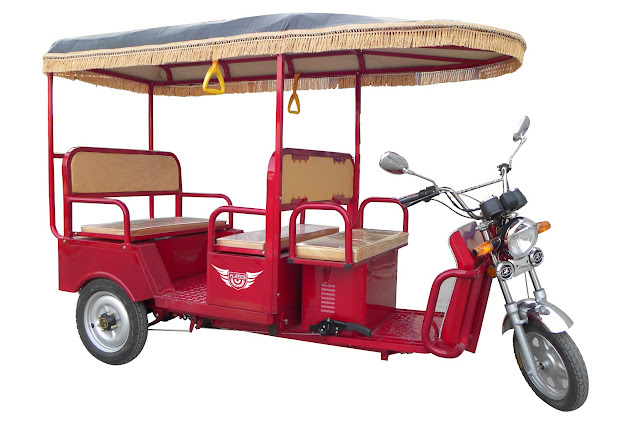E-Rickshaw - An Eco-Friendly Mode Of Local Transportation
 |
| E-Rickshaw |
What is an E-rickshaw?
An E-rickshaw, also known as battery operated auto or electric rickshaw, is a
three-wheeled electric vehicle that is used for transportation of passengers as
well as goods over short distances within cities and towns. E-rickshaws have
become an increasingly popular mode of transportation in developing countries
like India due to their affordability and eco-friendly nature.
The history of E-Rickshaw can be traced back to the 1930s when they were introduced in Japan. However, it was not until the late 1990s and early 2000s that they started gaining traction in India. With rising fuel prices and growing pollution levels in urban areas, E-rickshaws offered a viable alternative to petrol or CNG autorickshaws. By 2010, E-rickshaws had become mainstream in several Indian cities and are now a common sight on roads.
How do E-rickshaws work?
E-rickshaws are battery-powered vehicles that run on a lead-acid or lithium-ion battery. The battery is charged by plugging it into a regular power outlet. A single full charge can provide a range of 60-80 km depending on payload and driving conditions. E-rickshaws have a top speed of around 25 kmph. They are fitted with a small motor, usually rated between 250-750 watts. The motor draws current from the battery and powers the rear wheel. E-rickshaws are very simple vehicles with minimal mechanical parts and easy maneuverability- making them a cheap and practical mode of transportation.
Benefits of E-rickshaw
One of the biggest advantages of E-rickshaws is that they produce zero direct emissions and are highly eco-friendly. They do not use fossil fuels like petrol or diesel thereby reducing air and noise pollution in cities substantially. This makes them ideal for public transportation needs in congested urban areas. E-rickshaws are also inexpensive to purchase and maintain compared to fuel-run vehicles. Their operating cost per kilometer is as low as 50 paise making them affordable for drivers as well as passengers. Due to their quiet operation, E-rickshaws do not add to the problem of noise pollution either. Furthermore, they help reduce dependency on imported fuel and conserve non-renewable energy resources.
Popularity in India
India is one of the biggest s for E-rickshaws globally with an estimated 1 million vehicles plying on roads across the country currently. States like Uttar Pradesh, Bihar, West Bengal among others have witnessed the highest adoption of E-rickshaws for intra-city transport. They are especially popular in crowded cities and localities where narrow roads do not allow operation of conventional public transport vehicles. E-rickshaws have generated employment for thousands of drivers while providing cheap mobility options to people from all strata of society including women, children and elderly citizens. Their user-friendly features and hireability have made them a runaway success in tier 2 and tier 3 cities of India where last-mile connectivity was an issue earlier.
Challenges faced
Despite their popularity, E-rickshaws in India still face challenges with regard to acceptance, legal status and standardization. In many states they are considered unauthorized vehicles due to absence of any regulation. This leads to issues like lack of safety standards, overloading concerns and undisciplined driving practices. Furthermore, lack of dedicated charging infrastructure and standard battery technologies are areas that need to be addressed. High initial purchase cost compared to traditional rickshaws is another barrier, though government subsidies are helping address this to some extent. There are also debates around exempting E-rickshaws from age caps imposed on other commercial vehicles as batteries tend to degrade faster over the years. Overall, more coordinated efforts are required towards developing an enabling regulatory framework and policy support for E-rickshaw in India.
Future outlook
Considering the benefits they provide, the future of E-rickshaws looks
promising. Global sales are forecasted to grow at a CAGR of over 15% in the
next 5 years led by developing Asian countries. In India, rickshaw drivers and
unions have supported transition to E-models. With falling battery prices and
local assembly, their upfront cost will reduce further. Government schemes
providing subsidies up to 50% are encouraging large scale adoption. Newer
lithium-ion based models with longer range are also penetrating the.
Progressive state governments are framing detailed guidelines and designating
E-rickshaw zones/lanes for ensuring their smooth operation. If consistent
policy backing is received, E-rickshaws have the potential to emerge as the
preferred eco-mobility option in tier 2/3 cities of India while also promoting
energy independence.
Get
more insights, On E-Rickshaw



Comments
Post a Comment